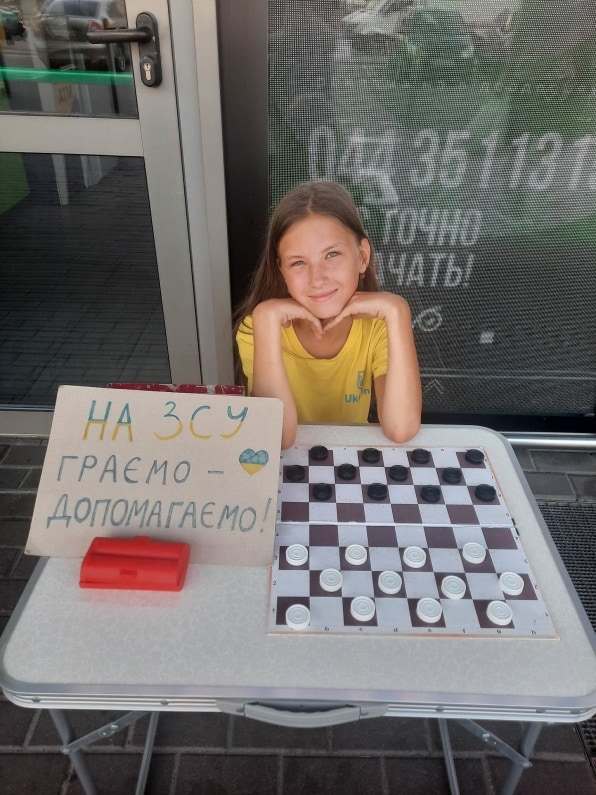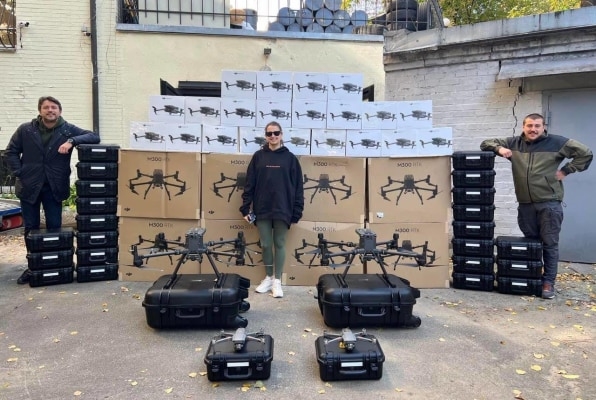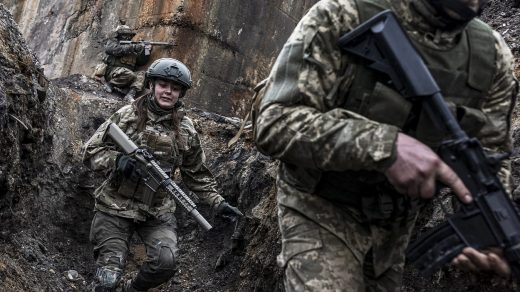‘Revenge crowdfunding’: How Ukrainians keep donating millions to support the war effort
By Liza Semko
Valeria Yezhova is only 11 years old, but she is already a world champion in draughts (similar to checkers in America); she has also donated more than $4,300 to the Ukrainian army, both through charity funds and helping military units directly. The Kyiv resident managed to collect the sum by playing the game with passersby on their way to the supermarket, along with volunteers and even judges from the High Anti-Corruption Court. According to her rules, a person who loses the game must donate any sum of money. But she says only a handful of players ever beat her in draughts.
The idea of supporting the army came to her after Ukrainian forces liberated the Bucha region, where her grandparents live. “It seems to me that nowadays Ukrainian children, no matter how old they are, realize that there is grief and war around them,” Yezhova says. “Ukrainian children have a big conscience.”
Then she adds, “Russians don’t have such a level of conscience.”
Having accumulated the first winnings from her tournaments, Yezhova handed over around $570 to the Serhiy Prytula Foundation, an eponymous charity set up by the noted Ukrainian showman, philanthropist, and former member of Ukraine’s pro-European Holos, or Voice, party. After Russia’s invasion began on February 24, 2022, the organization earned fame and a reputation with its outstanding crowdfunding campaigns, aiming to purchase three Bayraktar TB2 unmanned combat aerial vehicles, kamikaze drones, and Spartan armored personnel carriers, along with providing humanitarian aid to Ukrainians.
Yezhova also set an example for other children. Since last summer—the first time she brought her savings to the Serhiy Prytula Foundation—kids have donated around $168,000 to the organization.

According to Anna Hvozdiar, the foundation’s director, Ukrainians of all ages and backgrounds—children, adults, businesspeople, internally displaced persons, and others—regularly donate money to charitable causes, no matter what. She recalls people who barely escaped Russian-occupied territories who once gave away all their savings, totaling about $40,000.
“This is a huge donation because the people who saved [for their entire] lives and with great difficulty got out of the occupation and gave us everything they had,” Hvozdiar says. “For me, this donation is very big because it is a certain level of trust that we have to justify.”
She also recalls how even “old ladies” chipped in on purchasing Bayraktar drones, even though the average pension in the country is about $125 and the average salary, around $390. According to her, everyone wants to contribute to the aid and future victory.
Oleg Karpenko, head of partnerships at another big charity, Come Back Alive, says that at the beginning of the all-out war, one 87-year-old man donated $30,000 to the army through the charity. And he continues giving a part of his earnings to the foundation.
“His motivation is simple,” Karpenko says of the generous man. “He says that he wants to die in independent Ukraine. And he is sincerely hurt by what is happening.”
Since Russia unleashed a full-scale invasion of Ukraine, millions of Ukrainians have been donating part of their earnings to charitable causes, including arms procurement. Around half of Ukrainians donate to charities or volunteer regularly, and another quarter also volunteer but a little less so. For many people, it’s a way to contribute to the war efforts, grapple with stress, and get revenge on Russia for all the suffering it continues to inflict on Ukrainians. As Russian forces endeavor to crush Ukrainians’ spirits and increasingly deprive them of basic necessities—intensifying attacks on the country’s critical and civilian infrastructure—Ukrainians are getting angrier and respond by emptying their pockets for charitable aid.
“Something very massive”
Back in 2014, when Russia first invaded Ukraine, having occupied Crimea and part of the Donbas region, the burden of providing the Ukrainian military with ammunition partially fell on volunteers’ shoulders. Over the years, the situation has changed dramatically: The Ukrainian army is much better equipped and armored than it was nine years ago. But it still needs capital injections.
According to Ukraine Prime Minister Denys Shmyhal, one day of war costs the country around $54 million in state budget expenditures and $4 billion in terms of losses. And although Ukraine had increased its defense budget for 2023 to more than $30.9 billion, and has further increased it, the funds are still insufficient.
That’s where big philanthropy foundations and private volunteers step in. In addition to the Serhiy Prytula Foundation, other well-known Ukrainian charities are Come Back Alive and the state-run United 24. Yet another significant fundraising source for the Ukrainian army is a special bank account of the National Bank of Ukraine. Together, they raised almost $1 billion since the beginning of Russia’s invasion.
The funds come from both Ukrainian and foreign donors, but Ukrainians, obviously, take the lead here. Naya Novak, coordinator of the communications department at the Serhiy Prytula Foundation, says that about 20% of all donations to the organization come from abroad. But these calculations aren’t completely accurate because the total is based only on currency payment.
By uniting efforts, Ukrainians and foreign allies have collected millions of dollars in a matter of days for specific campaigns, such as the crowdfunding campaign for the Bayraktar combat drones, backed by Prytula’s foundation and Ukrainian blogger Ihor Lachenkov. In three days, people donated more than $16 million, enough to buy four drones.
According to Novak, 60% of those crowdfunded donations were no more than $27. Baykar, the Turkish producer of drones, was so impressed with the outpouring that it provided three drones for free. This freed up foundation funds for the purchase of a Finnish-produced satellite used to provide Ukrainian forces with high-resolution imagery of Russian military positions.
“This is a story when we are less afraid, when we feel that there are many of us,” says Hvozdiar. “We travel a lot across Ukraine, and people come up to us at gas stations, sellers in stores, and say that they chipped in for Bayraktars. It is very important for people to be a part of large crowdfundings. With such huge campaigns, we give them the opportunity to be involved in something very massive.”
And as attacks intensify, Ukrainians donate even more than usual. “There is a tendency that, amid shellings, the number of donations increases,” says Karpenko of Come Back Alive. “On average, they rise by 30% to 40%.”
Following Russia’s massive missile attacks on major Ukrainian cities last year, Prytula’s foundation and activist Serhii Sternenko launched a “revenge” crowdfunding campaign to buy RAM ?? kamikaze drones. They collected around $9.5 million, enough to purchase 142 drones for the Ukrainian army.
“People felt fear for themselves, their children, and their relatives,” says Hvozdiar. “Everyone felt it. For example, a missile fell close to my house. I understand that feeling, this fear; Ukrainians’ hatred [toward] the enemy is rising.”
And though sometimes Ukrainians don’t even know what they’re donating for, that doesn’t stop them. Such was the case with the Black Box campaign, launched by Come Back Alive. People know and trust this charity, which has been operating for nine years; its mission is to support the Ukrainian armed forces in everything from purchasing arms and equipment to providing training and first aid to soldiers. Without knowing any details—organizers reveal very little, understandably—Ukrainians joined together to contribute more than $6 million to the Black Box project. Organizers did disclose that “this thing” is used by the Ukrainian intelligence and has already borne fruit.

Banks sometimes stand in the way
Not all Ukrainian soldiers seek aid from big charities. Many turn either to private volunteers or their closest friends and family members, who crowdfund money deposited to their personal bank accounts. State-run PrivatBank and Monobank, operating under the Universal Banking License, are among the most-used institutions for this purpose.
Monobank offers an option to donate in a few clicks via its “charity jars,” which have become extremely popular among Ukrainians. To make the transaction, a user goes via the link to the jar, or scans a QR code, sending a remittance without any commission.
Over the past year, Ukrainians collected almost $300 million in donations through these charity jars, according to the cofounder and commercial director of Monobank, Oleg Gorokhovskyi.
Iryna Lutsak is one who uses this feature quite often. Between this and other services, she raises funds for the military unit in which her boyfriend, Artem Holub, serves. Since October 2022, when she discovered that her significant other was on the frontline, she has collected well over $70,000. This sum funded a Starlink device, power generator, thermal imagers, car repair, and anti-drone rifles.
But one day, she went to a shop with her card and wasn’t able to pay with it—Monobank had blocked her bank account due to seemingly suspicious cash deposits. Some users who raise funds for charitable causes can face the same problem, as hundreds or thousands of people may send them money at once. Banks consider these actions suspicious.
Monobank ultimately lifted the ban on Lutsak’s account once she provided documents to confirm that she was, indeed, raising money for the armed forces. She managed to send a few receipts for purchased goods, screenshots of Facebook posts announcing the crowdfunding, and screenshots of thanks to people who bought the necessary items for her boyfriend’s unit—and that was enough to convince the bank that her intentions were legitimate.
Monobank hasn’t responded to our request for comment on how the bank regulates donations. But another banking leader, PrivatBank, told Fast Company that “any restrictive actions are not a common practice for the bank,” and it requests additional documents “only if it has no other ways to clarify whether the financial transaction is transparent.”
Getting creative as donations shrink
Despite the fact that Ukrainians donate regularly, the economic downturn has taken its toll on people’s earnings, and donations have decreased compared to the beginning of the full-scale invasion, say representatives of Come Back Alive and the Serhiy Prytula Foundation.
As a result, some charities are seeking ways to engage more foreign audiences in crowdfunding campaigns. For example, Come Back Alive is going to open an office in the United States. There, it doesn’t plan to raise money for military purposes but will fundraise for the development of analytics in the military sphere, adaptation and reintegration of veterans, and the demining of the Ukrainian territories. Karpenko hopes it will happen this summer.
“We understand that requests and needs are growing,” he says. “Accordingly, the projects we plan will be impossible to implement with the funds of Ukrainians only.”
Back at the Prytula Foundation, Hvozdiar says that it too expects to expand its activities abroad, but not right now. At the same time, she calls on the foreign audience to donate more to the cause. Ukraine is the last outpost in front of Europe, she says, so if Ukraine falls, Russia will attack Poland and other countries: “If NATO fighters from different countries don’t want to die in Poland tomorrow, it is important for Ukraine to win today so that the war stops, ends here, and never happens again.”
(23)



